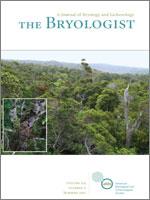Three prominent life history patterns attributed to dioecious species of mosses (low sex expression, male rarity, and low frequencies of sexual reproduction) were investigated in the desert moss Syntrichia caninervis along an elevation gradient in the Spring Mountains of the Mojave Desert (U.S.A.). Low elevation patches exhibited significantly lower frequencies of sex expression, individuals with fewer inflorescences, and fewer male individuals. Sexual reproduction was infrequent at all elevations, with only seven of 85 patches showing evidence of recent sporophyte production and only nine of 708 perichaetia being fertilized. After factoring out abortive sporophytes, the percentage of patches maturing sporophytes was 5.9% and the estimated fraction of fertilized perichaetia was 0.7%. In addition, as elevation increased from low to middle/high elevation, individuals of Syntrichia caninervis exhibited significant increases in biomass, total stem length, number of ramets, and ramet length. The decreased availability of water at lower elevations may stunt individual plant size, inhibiting sex expression, and promoting growth of female-only individuals, thereby depressing sexual reproduction. Our data are consistent with the hypothesis that male rarity may be caused in part by differential desiccation tolerance between the sexes, with males less able to tolerate repeated cycles of hydration and desiccation due to their higher energetic requirements for sex expression.
How to translate text using browser tools
1 June 2011
Plant size, sex expression and sexual reproduction along an elevation gradient in a desert moss
Michael Benassi,
Lloyd R. Stark,
John C. Brinda,
D. Nicholas McLetchie,
Mary Bonine,
Brent D. Mishler
ACCESS THE FULL ARTICLE

The Bryologist
Vol. 114 • No. 2
Summer 2011
Vol. 114 • No. 2
Summer 2011
biomass
Bryophyte ecology
Dioecy
Mojave Desert
moss
sex ratio




